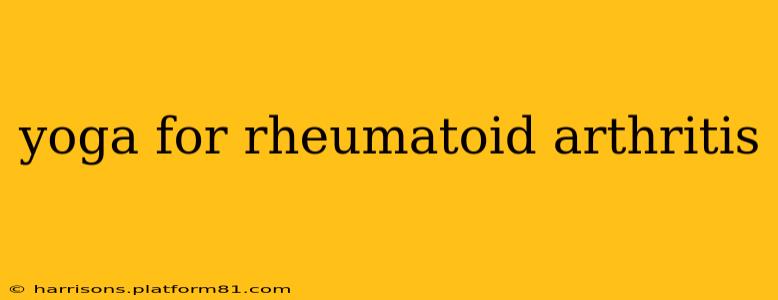Rheumatoid arthritis (RA) is a chronic autoimmune disease that causes pain, swelling, stiffness, and limitations in joint movement. While medication plays a crucial role in managing RA, many find that incorporating complementary therapies like yoga offers significant benefits in improving their quality of life. This article explores how yoga can help manage RA symptoms and enhance overall well-being. We'll delve into the specific benefits, address common concerns, and provide guidance on getting started safely.
What are the benefits of yoga for rheumatoid arthritis?
Yoga offers a multifaceted approach to managing RA. The gentle movements and stretches can improve flexibility and range of motion in affected joints, reducing stiffness and pain. Moreover, yoga's emphasis on mindful breathing techniques helps to reduce stress and anxiety, which are often exacerbated by the chronic pain and limitations associated with RA. Studies have shown that regular yoga practice can lead to:
- Improved joint mobility and flexibility: Specific yoga poses can gently increase range of motion in stiff joints, making everyday tasks easier.
- Reduced pain and inflammation: Gentle stretching and mindful movement can help to alleviate pain and reduce inflammation in the joints.
- Increased muscle strength and endurance: Yoga strengthens muscles supporting the joints, providing stability and reducing strain.
- Stress reduction and improved mood: Mindfulness and relaxation techniques embedded in yoga practice can help manage stress, anxiety, and depression often associated with chronic illness.
- Improved sleep quality: Stress reduction and pain management contribute to better sleep patterns.
- Increased self-esteem and body image: Yoga fosters a sense of self-acceptance and empowers individuals to manage their condition.
Is yoga safe for people with rheumatoid arthritis?
It's crucial to approach yoga with caution if you have RA. Always consult your doctor or rheumatologist before starting any new exercise program, including yoga. They can assess your specific condition and recommend appropriate modifications. Finding a qualified yoga instructor experienced in working with individuals with arthritis is also vital. They can adapt poses to suit your limitations and provide modifications to avoid exacerbating symptoms.
What type of yoga is best for rheumatoid arthritis?
Gentle forms of yoga are generally recommended for people with RA. These styles focus on slow, controlled movements and mindful breathing, minimizing the risk of injury. Some suitable styles include:
- Hatha yoga: A gentle style that emphasizes basic poses held for longer durations.
- Restorative yoga: Focuses on deep relaxation and passive stretching, using props for support.
- Yin yoga: Targets deep connective tissues through long-held, passive poses.
Avoid styles like Ashtanga or Vinyasa yoga, which are more vigorous and may put too much stress on inflamed joints.
What are some yoga poses that are beneficial for rheumatoid arthritis?
While specific poses should be tailored to individual needs and limitations, some generally beneficial poses include:
- Child's Pose (Balasana): A restorative pose that gently stretches the hips, thighs, and ankles.
- Cat-Cow Pose (Marjaryasana to Bitilasana): A gentle flow that improves spine flexibility and mobility.
- Downward-Facing Dog (Adho Mukha Svanasana): (Modified as needed) Stretches the hamstrings, calves, and shoulders.
- Tree Pose (Vrksasana): (Modified as needed) Improves balance and strengthens legs.
- Seated Forward Bend (Paschimottanasana): (Modified as needed) Stretches the hamstrings and spine.
How often should I practice yoga if I have rheumatoid arthritis?
The frequency of yoga practice depends on your individual condition and tolerance. Start slowly, perhaps with two or three short sessions per week, and gradually increase the frequency and duration as you feel comfortable. Listen to your body and rest when needed. It's better to practice consistently at a manageable level than to push yourself too hard and risk injury.
Can yoga cure rheumatoid arthritis?
No, yoga cannot cure rheumatoid arthritis. However, it is a valuable complementary therapy that can significantly improve the management of symptoms and enhance quality of life. It works best when combined with medical treatment prescribed by your doctor.
Where can I find a yoga instructor experienced in working with people with rheumatoid arthritis?
Many yoga studios offer specialized classes for individuals with arthritis or other chronic conditions. You can search online for studios in your area that offer such classes or contact your rheumatologist for recommendations.
By incorporating yoga into your RA management plan, you can experience a significant improvement in your physical and mental well-being. Remember to always prioritize safety and listen to your body’s signals. With the right approach, yoga can be a powerful tool in your journey to living a healthier, more fulfilling life with rheumatoid arthritis.
